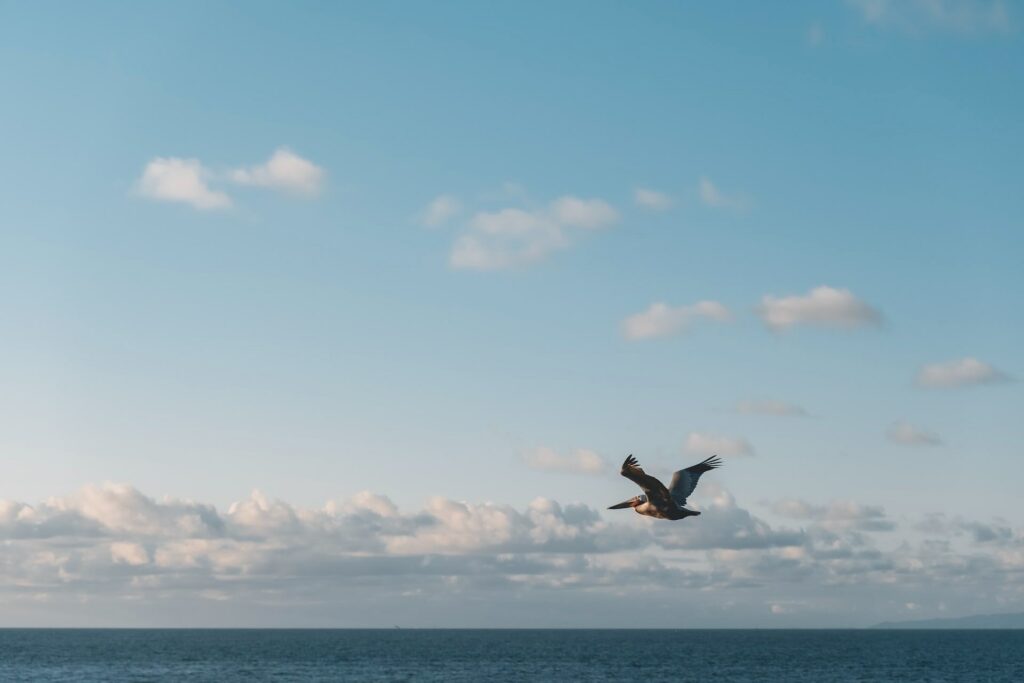You can see some amazing seabirds on our City Cruises Whale Watch cruise in San Diego, the most common of which can be found here. Here are some other, less common seabirds, including several species of herons, that can be found in San Diego Bay.
Reddish egret (Egretta rufescens)
The reddish egret is a fairly large heron with a gray body, a reddish neck, and bluish-black gray legs. Its bill is mostly pink and tipped with black. This active egret searches for food in shallow, saltwater habitats and often runs and hops to catch fish with its wings spread out. San Diego is near the northern part of the range for this species on the Pacific Coast.
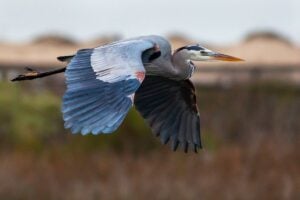
Lille blåhejre (Egretta caerulea)
Den lille blåhejre er en lille hejre med en mørk blågrå krop og et lilla til mørkerødt hoved og hals. Unge fugle er for det meste hvide med lysegrå vingefjer. Når den lille blåhejre jager fisk og frøer i lavvandede ferskvands- eller saltvandsområder, står den lille blåhejre stille på lavt vand og venter på, at potentielle byttedyr svømmer i nærheden.
Trefarvet hejre (Egretta tricolor)
Denne mellemstore hejre er mest mørkegrå med hvid bug og rødlige fjer på hals og ryg. Ungerne har en hvid streg ned langs halsen. Når den søger føde, står den enten og venter på, at fisk svømmer forbi, eller den går for at røre bunden op med en fod for at skræmme byttet.
Green heron (Butorides virescens)
This small, beautifully-colored heron typically rests in a crouched position at the water’s edge often hidden within vegetation. It has a greenish back with a chestnut neck, face, and chest, white streaks on each cheek and throat, dark gray wings, a gray and yellow bill, and yellow legs. The green heron usually sits at the water’s edge and waits for fish and frogs to move by, then spears them with its dagger-like bill.
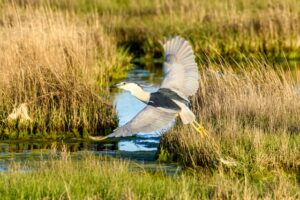
Black-crowned night heron (Nycticorax nycticorax)
The black-crowned night heron is fairly stocky with relatively short yellow legs. The plumage is dark gray from the top of its head to the back, with light-gray wing feathers, and white from the face to the belly. It also has a white patch extending from the base of the upper bill to above the red eyes. Juveniles are mottled brown and white. As its name implies, the black-crowned night heron feeds from dusk until dawn, searching for insects, worms, fishes, amphibians, and other small land and aquatic animals.
Brandt’s cormorant (Phalacrocorax penicillatus)
The Brandt’s cormorant is an iridescent black seabird found in saltwater habitats along the Pacific Coast of North America. Adults have a pale patch at the base of the throat, a bright blue throat pouch, and fine, white plume feathers on their head, neck, and back during the nesting season. During the non-breeding season, adults are much duller in color while juveniles are also a much duller brownish-black. Cormorants swim at the surface and then dive to catch fish or squid, using their webbed feet to actively swim after prey. Like other cormorants, the Brandt’s cormorant holds its wings out to dry after diving.
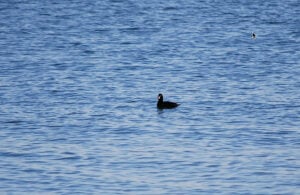
Surf scoter (Melanitta perspicillata)
This sea duck is strikingly patterned in black-and-white. The male is all black with a white forehead patch and a white patch on the back of his neck, and a white, orange, and black patterned bill. The female is a lighter brownish-black with white patches on each side of the head and at the base of the mostly dark gray bill. Nesting takes place during summer in freshwater lakes in high-elevation forests and the tundra mainly in Alaska and Canada. Surf scoters can be found in winter along both coasts of North America where it can often be seen diving for mollusks, crustaceans, and other aquatic invertebrates.
Pacific brant (Branta bernicla)
This small sea goose has a black head, neck, and chest with a broken white “collar” in the upper neck region, a brownish back, a black to light gray belly, and a white rump. The Brant nests in the Arctic on the tundra and spends winters feeding on eelgrass, sea lettuce, and other aquatic plants along both coasts of North America. The Pacific subspecies of brant winters from British Columbia to Baja California, Mexico, and can often be seen swimming and feeding in flocks during the late fall to early spring months in San Diego Bay.
Western grebe (Aechmophorus occidentalis)
The western grebe is a black and white grebe with a long neck, a spear-like yellow bill, and red eyes. This species has a black back with black extending along the back of its neck and a black cap that extends below the eyes. The almost identical Clark’s grebe can be distinguished from the western grebe by its white face (its black cap does not extend below the eyes). Western grebes nest on freshwater lakes and marshes and overwinter in bays, estuaries, and sheltered coasts. They dive to catch fish and occasionally crustaceans and aquatic worms. In the summer nesting grounds, adults perform an elaborate courtship display by rushing across the water with their necks extended.
Pied-billed grebe (Podilymbus podiceps)
The pied-billed grebe is a small, stocky, brown, bird with a short wedge-shaped bill, a brown body, and an extremely short tail. Their bill is marked with a vertical black stripe in the summer giving rise to their common name. Pied-billed grebes dive to hunt small fishes, crustaceans, insects, amphibians, and other small aquatic animals in freshwater lakes, rivers, marshes, and saltwater estuaries and bays.
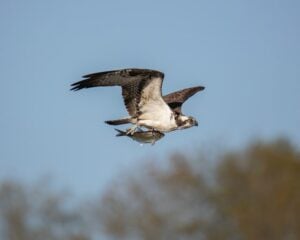
Osprey (Pandion haliaetus)
The Osprey is a common fish-eating hawk spotted in freshwater and saltwater habitats worldwide except in Antarctica. These attractive birds of prey are black to brown and white and have hooked bills and yellow eyes. They have a reversible outer toe on each foot and barbed pads on the soles that let them catch and easily grasp slippery fish. Osprey pairs build huge nests of sticks and other vegetation that are added to each nesting season and used from year to year. Often these nests are built on sea stacks, dried tree snags, and even man-made structures such as light towers, utility poles, and artificial platforms. Some of these nests are decades old and can be 10 to 13 feet tall and 3 to 6 feet across.
Brun pelikan(Pelecanus occidentalis)
Den brune pelikan er den største nordamerikanske pelikan. Disse store fugle har et karakteristisk pukkelrygget udseende, lange halse og et stort næb med en halspose, der bruges til at opsamle fisk. Pelikaner er for det meste mørkebrune med nogle lysere gråbrune farver på vingerne og halsen. De kan findes i kystområder i store dele af Nordamerika, hvor de næsten udelukkende lever af små fisk, som de fanger ved at kaste sig ned fra luften i vandet. Den yngler langs kysterne fra Virginia til Texas og Californien og inde i landet langs de store søer.
Amerikansk hvid pelikan(Pelecanus erythrorhynchos)
The American white pelican is one of the largest North American birds, with a wingspan reaching almost 10 feet. They are all white with black wingtips and have a long bill with a large throat pouch used for scooping up fish. Pelicans feed cooperatively, swimming in groups to herd and trap small fishes in shallow water where they can be easily caught. These big birds breed along inland lakes in western Canada and the northern United States and spend winters along coasts from California to Texas.
Pelagisk skarv(Phalacrocorax pelagicus)
Den pelagiske skarv er en skarvart, der yngler i åbne havområder rundt om i verden. Denne fugl er helt sort, har et langt, kroget næb og svømmefødder. Den pelagiske skarv er en fremragende svømmer og kan dykke ned til over 150 fods dybde på jagt efter fisk. Disse fugle bygger typisk rede på klippevægge eller i træer i nærheden af vandområder. Den pelagiske skarv er et socialt væsen og danner ofte store kolonier med andre fugle. Denne art er dog ikke uden rovdyr; måger, ørne og andre rovfugle er ofte mål for pelagiske skarver.

Dobbeltskråpe(Phalacrocorax auritus)
Skarven er en stor vandfugl med en lang hals og et kroget næb. Den findes i ferskvands- og saltvandsområder i store dele af Nordamerika. Dobbeltskarven er en fremragende svømmer og dykker og lever af fisk, krebs og andre vanddyr. Fuglens mørke fjerdragt er med til at camouflere den for rovdyr, og dens svømmefødder hjælper den til at padle hurtigt gennem vandet. Dobbeltskarven er en beskyttet art, og dens antal er steget i de seneste år. Fuglens vane med at bygge rede på menneskeskabte strukturer som f.eks. el-ledninger og både har dog forårsaget nogle konflikter med mennesker.
Klippedue(Columba livia)
Klippeduen er en dueart, der er hjemmehørende i Europa, Asien og Afrika. Det er også den mest almindelige fugl i byerne. Klippeduven er en mellemstor fugl med en buttet krop og korte ben. Dens fjerdragt er normalt grå eller blå, men kan også være hvid, brun eller sort. Fuglen har et lille hoved med et spidst næb. Klippeduer lever typisk i flokke og ses ofte på jagt efter føde i byområder. De er også kendt for deres kurrende vokalisering. Klippeduen er en vigtig art både i naturen og i fangenskab. Den bruges ofte i forskning på grund af dens evne til at tilpasse sig forskellige miljøer. Klippeduen er også blevet indført i mange dele af verden, hvor den er blevet etableret som en plageart.
Konklusion
Hvis du ønsker at se nogle af de mindre almindelige havfugle i San Diego Bay, skal du se vores liste. Selv om mange flere arter kan ses her, mener vi, at disse femten vil give dig et godt udsnit af, hvad der er derude. Har du spottet nogle af disse fugle på dine ture rundt i bugten? Lad os vide det i kommentarerne nedenfor!


